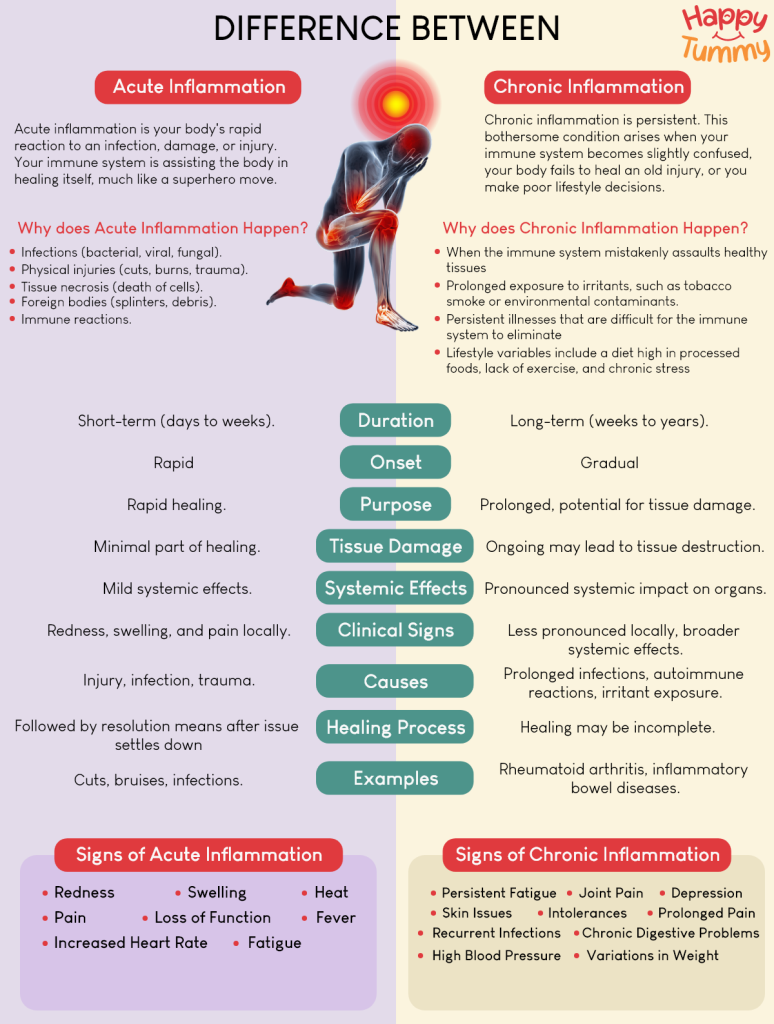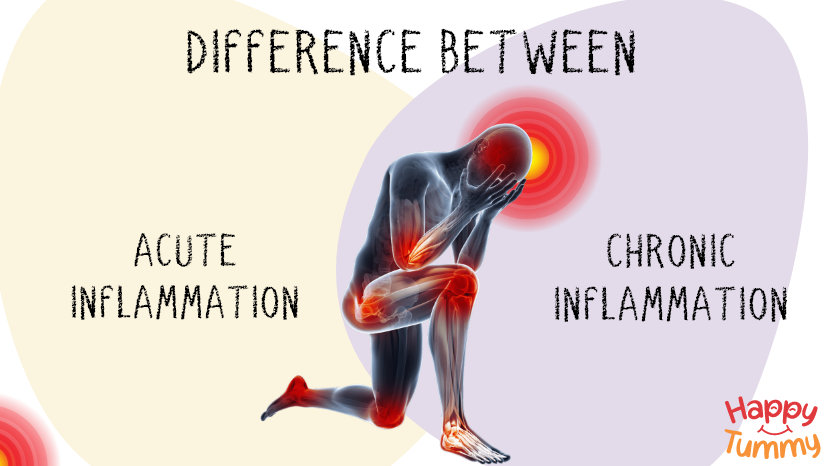Table of Contents
You get a cut or a wound, and it heals on its own, and you might wonder how that happens. Is it magic happening within the body? Is there any mechanism that’s in the play? Our body is capable of much more than we can even think of. This magic band is nothing but called inflammation.
The body uses inflammation to signal, “Hey, there’s a problem here, and I’m working on fixing it!” It is a natural defense response against injury or disease. Consider it the body’s method of alerting you to a problem that requires attention. Like a warning sign, it prompts the immune system to act and start healing.
Although inflammation is a normal and essential part of the healing process, chronic inflammation can be harmful and a leading factor in various health issues. Let’s divide inflammation into acute and chronic groups to simplify things for you to comprehend. Things become evident when we look at each one in greater detail:
Acute Inflammation
Let’s say you chop vegetables and cut your finger by mistake. Oh no! That’s when your body’s superhero squad should start working. It’s similar to always having first responders ready for anything. To let more blood in, the blood vessels near the cut first decide to have a small party and enlarge. That’s why your cut instantly looks red and feels warm. It feels as though your body is alerting you to a problem and taking care of it.
The significant part is that all of this chaos is temporary. Acute inflammation is your body’s rapid reaction to an infection, damage, or injury [1]. Your immune system is assisting the body in healing itself, much like a superhero move.
This process allows your body to eliminate damaged cells and tissues, like a cleanup crew. Acute inflammation is a vital part of the immune system’s toolbox, working to fix things and make you feel better. In this case, the fundamental features you might observe generally include the following [2].
- Rapid Onset: Acute inflammation begins quickly after the body recognizes an injury or infection, often within minutes to hours.
- Duration: Short-term; after you address the triggering, it usually resolves in a few days to weeks.
- Purpose: The primary goal is to defend the body against harmful stimuli and promote tissue repair. Thus, the role of acute inflammation aids in the removal of injured cells. By isolating and eliminating unwanted bacteria, it promotes the development of a healing environment.
- Vascular Changes: Blood vessels near the affected area expand to increase blood flow, leading to redness and warmth. As soon as they see an injury, immune cells rush there. Your infected area will be flooded with increased blood vessels.
- Clinical Signs: Localized signs include redness, swelling, heat, and pain. Fever, an accelerated heart rate, and raised particular proteins in the blood are examples of systemic symptoms.
- Resolution: Once the threat is neutralized or the healing process is underway, anti-inflammatory signals help resolve the inflammatory response.
Also read – Types of Foods That Cause Inflammation
Why does Acute Inflammation happen?
- Infections (bacterial, viral, fungal).
- Physical injuries (cuts, burns, trauma).
- Tissue necrosis (death of cells).
- Foreign bodies (splinters, debris).
- Immune reactions.
Signs of Acute Inflammation
Everybody has occasionally felt discomfort, irritation, and swelling. It is nothing but acute inflammation. So, in general, the symptoms are visible in the affected regions. If the whole body is affected, the symptoms could appear differently. So, let’s talk about the many acute inflammation symptoms that range from person to person [3].
- Redness: The afflicted area may appear visibly red due to increased blood flow.
- Swelling: You may notice an accumulation of fluid because of the increased permeability of blood vessels.
- Heat: The inflammation area becomes warmer due to the increased blood flow.
- Pain: You might expect pain or discomfort because of the pressure from swelling and the production of inflammatory mediators.
- Loss of Function: Severe cases may result in discomfort and swelling to the point where function in the afflicted area is lost.
- Fever: In reaction to an injury or infection, the body may become more heated, which makes it harder for germs to thrive.
- Increased Heart Rate: The heart beats more quickly to get nutrients and immune cells to the location of inflammation.
- Fatigue: You will get feelings of exhaustion and sluggishness.
Chronic Inflammation
Alright, let us discuss chronic inflammation. It’s like having a stubborn guest that never goes away. In contrast to acute problems, chronic inflammation is persistent. This bothersome condition arises when your immune system becomes slightly confused, your body fails to heal an old injury, or you make poor lifestyle decisions [4]. It resembles a tiny fire that never goes out and can potentially cause more significant issues.
An immune response lasting for a long time—often weeks, months, or even years—is called chronic inflammation. In contrast to acute inflammation, a short and defensive activity, chronic inflammation is linked to many illnesses and can cause tissue damage. In this case, you may typically notice the essential characteristics mentioned below [5].
- Duration: Persistent and long-lasting, sometimes with a delayed and gradual onset.
- Reason: Failure to treat the underlying cause of acute inflammation, autoimmune reactions, or exposure to low-level irritants such as environmental toxins, specific lifestyle choices, or recurrent infections can all lead to chronic inflammation.
- Cellular Invasion: One defining aspect is infiltrating immune cells into the afflicted tissues. Inflammatory mediators, which comprise different signalling molecules including cytokines and chemokines, are released by these immune cells. Although these mediators are essential for coordinating the immune response, tissue damage may result from their excessive or dysregulated release.
- Tissue Damage and Restoration: Chronic inflammation may result in attempts to repair damaged tissue and subsequent creation of scar tissue (a collection of cells and collagen that covers the site of the injury).
- Systemic Impacts: In contrast to acute inflammation, chronic inflammation may not necessarily show up as redness and swelling. Systemic impacts include joint discomfort, muscular aches, weariness, and an overall feeling of being unwell.
Why does Chronic Inflammation Happen?
Autoimmune illnesses occur when the immune system mistakenly assaults healthy tissues. Another significant factor is prolonged exposure to irritants, such as tobacco smoke or environmental contaminants.
It also happens due to persistent illnesses that are difficult for the immune system to eliminate. Lastly, lifestyle variables include a diet high in processed foods, lack of exercise, and chronic stress, contributing to chronic inflammation.
Signs of Chronic Inflammation
You may now ask yourself if you have chronic inflammation or how to check it in your body. Here, we’ll talk about the signs of chronic inflammation and offer comprehensive symptoms on monitoring your health and treating it so you can stay well [6].
- Persistent Fatigue: Even with adequate sleep, feeling worn out may indicate persistent inflammation.
- Joint Pain: Inflammation that persists may result in joint stiffness, swelling, or pain.
- Chronic Digestive Problems: Chronic inflammation may cause persistent problems such as bloating, irregular bowel movements, or abdominal pain.
- Recurrent Infections: If your immune system is weakened by ongoing inflammation, infections may occur more frequently or persist longer.
- Skin Issues: Psoriasis and eczema are two disorders where chronic inflammation may worsen.
- Intolerances: Prolonged inflammation can cause allergy symptoms and increased sensitivity.
- High Blood Pressure: Prolonged inflammation may impact blood vessel health, resulting in high blood pressure.
- Variations in Weight: Unexpected weight gain or trouble decreasing weight may be related to chronic inflammation.
- Prolonged Pain: Chronic inflammation may be indicated by pain that doesn’t seem to be due to a recent injury.
- Depression or shifts in mood: There is a connection between mood swings, particularly depressive symptoms, and chronic inflammation.
- Increasing Blood Sugar: Insulin resistance and elevated blood sugar levels are signs.
Key Takeaway

It is essential to understand the signals that your body gives you. The earlier you catch the signs, the easier it is to stay fit. After all, a happy mind rests in a healthy body. So, to thoroughly analyze the difference between acute and chronic inflammation, we provide you with the tabular form.
| Acute Inflammation | Chronic Inflammation | |
| Duration | Short-term (days to weeks). | Long-term (weeks to years). |
| Onset | Rapid. | Gradual. |
| Purpose | Rapid healing. | Prolonged, potential for tissue damage. |
| Tissue Damage | Minimal part of healing. | Ongoing may lead to tissue destruction. |
| Systemic Effects | Mild systemic effects. | Pronounced systemic impact on organs. |
| Clinical Signs | Redness, swelling, and pain locally. | Less pronounced locally, broader systemic effects. |
| Causes | Injury, infection, trauma. | Prolonged infections, autoimmune reactions, irritant exposure. |
| Healing Process | Followed by resolution means after issue settles down | Healing may be incomplete. |
| Examples | Cuts, bruises, infections. | Rheumatoid arthritis, inflammatory bowel diseases. |
Chronic inflammation is detrimental and may result in illness. Your lifestyle and food choices frequently cause or intensify inflammation.
To achieve optimal health and well-being, reduce your risk of disease, and enhance your quality of life, you should strive to pick anti-inflammatory foods.
Frequently Asked Questions
Treatment is not usually necessary for inflammation. Rest, ice, and good wound care often relieve discomfort for acute inflammation in a few days.
If you experience chronic inflammation, your physician can suggest using vitamins like zinc supplements and some vitamins (A, C, and D), which may improve healing and lessen inflammation.
By adopting better habits, you may be able to lower your chance of developing chronic inflammation. Among these habits are the following:
a. Attaining and holding onto a healthy weight.
b. Preventing or giving up smoking.
c. Engaging in physical activities three to five times a week minimum.
d. Reducing the amount of alcohol you consume.
e. Managing stress with healthy methods like meditation or writing.
Consult a medical professional if you sustain an injury that seems concerning. You should consult a professional if you continue to have pain, swelling, stiffness, or other symptoms. A medical professional can identify the problem and provide treatment options to make you feel better.
















